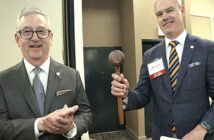
By Dave Ongie
Duane Miller, Executive Director of the LENOWISCO Planning District Commission, said a feasibility study into whether his sector of Southwest Virginia spanning the counties of Lee, Wise, Scott and the City of Norton had competitive hosting sites for Small Modular Reactors (SMR) was a step into the unknown.
When the results of that study were announced on Monday, however, seven sites in the area were deemed feasible to house SMRs, which are designed to deliver safe, reliable and clean nuclear energy on a smaller scale. The study, which was funded by the Virginia Department of Energy and GO Virginia One, was commissioned in response to Virginia Glenn Youngkin’s announcement of his “moonshot” goal last fall of having the first SMR up and running in Southwest Virignia within a decade.
“This region ranks as high as any in the nation that is pursuing or has SMRs already,” said Mike Little with Dominion Engineering, Incorporated (DEI), the Reston, Virginia-based company that completed the study. DEI assessed factors such as population size and existing energy infrastructure.
The direct benefits of having a 300 MW SMR located in Southwest Virginia were outlined in the study. A typical SMR of that size has a 40-year lifespan and creates approximately 40-60 jobs, not counting the hundreds of construction-related jobs that would be created. Furthermore, the United Staes Department of Energy estimates that a 300 MW SMR would provide over $100 million in new local tax revenue over an 18-year span.
But Miller and representatives from DEI say the benefits of housing a 300 MW SMR in Southwest Virginia is likely to create a positive economic ripple effect that would reach well beyond the reactor site. Several existing initiatives would likely receive a boost from a reactor being located in the area.
The report indicated the Energy DELTA Lab that was recently established near Norton would gain synergy with the development and deployment of SMR technologies. The lab, through Project Oasis, is developing methods of utilizing 52-degree water contained in underground mine pools to help cool the SMRs. Representatives from DEI added that Northern Virginia was already known as the data capital of the world, and the availability of billions of gallons of cool, clean mine water will also be attractive to data centers that need to keep their servers cool.
Representatives from DEI added that Southwest Virginia’s long history with the coal mining industry gives the region some built-in advantages other regions of the country don’t have when it comes to attracting an SMR and other new industries. For example, many of the prospective sites that showed great promise for housing an SMR were former mine properties. According to DEI, previously mined land is tailor-made for adding new industrial features without much prep work.
Additionally, the infrastructure in place to move coal out of the region – by highway and by rail – is another advantage. Applying for right-of-way for rail or highways can be a major headache. Finally, the human capital in place – a proven workforce – is perhaps Southwest Virginia’s greatest asset.
As for next steps, Miller said the LENOWISCO Planning District Commission expects to make an announcement soon regarding an SMR supply-chain study. Meanwhile, Virginia Energy is a likely candidate to take the lead on community engagement and outreach.
Landing an SMR in Southwest Virginia promises to be a long process. Both Dominion Energy and AEP have expressed support for the project, but Nuclear Regulatory Commission approvals prior to construction means it will likely take 10 years before the first SMR is operational.
Miller understands the race ahead is a marathon, but he is thrilled with the head start provided by the cooperation that has already taken place between Lee, Wise and Scott counties, the City of Norton and the stakeholders located within that geographic footprint. “We hit the ground running with this study,” Miller said.



